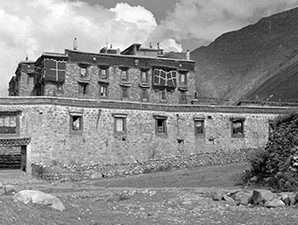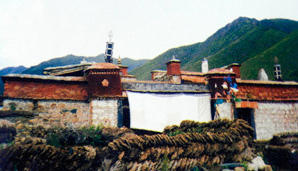


Drikung Tse Saten Dorje Ying (‘bri gung rtse sa brtan rdo rje dbyings), about eight kilometers upstream from Drikung Dzong, is said to having been built originally by Tibetan King Mutik Tsenpo (764-817) as a manor house (pho brang) in a narrow gorge off the upper Kyichu river crossing the Lungsho valley which leads to Lake Namtso. The building was first consecrated as a monastery by Chogyal Rinchen Phuntsog (1547-1602), the 21st throne holder of the Drikung order, in 1560. Chogyal Rinchen Phuntsog made it his main residence. From then on, the enthronement ceremonies of the new lineage holders were traditionally first performed here and only subsequently at Drikung Thil. The main building of Drikung Tse was enclosed by a wall and could be entered by a low, wooden-framed gateway.
The most sacred image at Drikung Tse was a statue of the Buddha created of a mysterious metal alloy. It is said that it had been made during Buddha’s lifetime and that it had been consecrated by him personally. Allegedly the Indian master Jowo Atisha (982-1054) brought it from India. Drikung Tse housed many beautiful statues, thangkas, and ancient manuscripts. Some very rare precious jewels were kept in the Achi treasury. In it also some kind of wooden miracle box was kept with the image of an elephant that was held to have magic properties, providing accumulation of wealth.

When Drikung Tse was destroyed after 1959, the local populace was amazed to see all the treasures that were brought out from the Achi treasury during the pillage, like a sizable bag filled with precious Dzi stones. Eyewitnesses also recounted that they had seen the elephant on the magic box beginning to bleed.
Today only a few monks live in the compound. They try hard to refurbish the buildings and restore religious life in this historically important Drikung Kagyu monastery.

